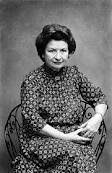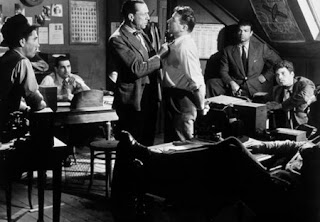Haunting melodies
I've got a bit of a fascination for ear-worms - those persistent melodies that get into your head and refuse to leave. In fact I'm so interested in them that having to write a blog post at short notice in one of my other non-Bookhound lives, I wrote about ear-worms, and in doing so came across Theodor Reik's fascinating book, The haunting melody, which was first published in the United States in 1953.
Reik was one of Freud's first pupils. Placed outside the psychoanalytical establishment because of his lack of medical training, he later founded the National Psychological Association for Psychoanalysis, which became one of the best training centres in its field in New York. Raised in a poor but cultured Viennese family, Reik grew up with music, and discussion about music all around him - one of his earliest memories was extensive debate about the new director of the Vienna Opera, Gustav Mahler.
The haunting melody was a book with a long gestation period. The germ that would turn into the book surfaced when, as a young man, Reik was asked to give an address at a memorial service for Karl Abraham, who had been an enormous influence on the young Reik. Struggling to decide what to say, the melody of the chorus from the last movement of Mahler's 2nd Symphony stormed into Reik's head and refused to go away until the memorial address was written. Puzzled by this Reik began a long journey researching Mahler, and instances of "haunting melodies".
The book is written in an engaging style, and is generally easy-reading. I had rather mixed feelings about it however. The latter half of the book is, as much as anything, a psychoanalytical study of Mahler, and is (especially for a Mahler lover) truly fascinating. I suspect that if however, you were less fond of Mahler, the latter half might be a bit of a quagmire.
The first half, although there is also plenty of Mahler, is principally about instances of haunting melodies affecting Reik's patients, with a few instances taken from the work of other therapists. Underlying all the psychoanalytical work teasing out where these melodies come from, are the theories of Freud and the great psychoanalytical works of the early 20th century. Oddly what struck me most about the first half of the book was how repressed people were in the 1950s. Perhaps it's just that Freud's theories on sexuality are now part of us. We don't need to figure it all out any more, it is rather more obvious. I came to the psychoanalyst's conclusion about several of his patients quite a few steps in front of him and without any tedious unpicking of musical threads. Rather than an age of freedom, I saw the 50s clearly in this volume as a conservative, closeted age. This was quite a surprise, as although I obviously realised that the sexual mores of the time were very different to today, nowhere had I seen it so clearly presented as in this book. Fascinating.
I am a Mahler lover. I remember being interviewed about him at my university admissions interview "But don't you find him depressing?" As a fairly angst ridden teenager, I was more than happy to be depressed by Mahler. I listen to his music now infrequently, but whenever I do I'm always struck anew by its power and beauty. Yes, he is dark, but this is one of the things that I love about him. One nice detail of Reik's Haunting Melody is that it brings out the humour in Mahler's character, which is also rather dark and witty.
A thoroughly enjoyable and thought-provoking book, if a little dense in sections.
Reik does point out early on that he suspects that "haunting melodies" work rather differently in musicians, where they may be rather more pre-occupied with musical associations, rather than other psychological meanings. I think that this is generally true of me. I've certainly realised recently that when I have conjoined tunes in my head (i.e. 2 completely separate tunes that seem to have merged into each other, perhaps morphing halfway through from one tune to another), it is inevitably because they share a few bars of melody in common. So my musical brain sings one tune up to the common bar and then swaps to the other one - an unintentional medley arrangement.
I only have a few instances of haunting melodies in the true Reik sense in my own life. The moment my mother died, Denn alles fleisch es ist wie gras, from Brahms' German Requiem, thundered into my head, and refused to leave until the funeral service. It was extremely appropriate in the circumstances, Mum had died well before her time, and in a great deal of pain, and the force of the chorus seemed to reinforce this.
On the other hand "Voi che sapete" from The marriage of Figaro is my "happy song". If I catch myself whistling or singing this then I know I'm happy. I have no real idea why this is so. It was one of the first songs I learned to read from an old music book of my father's (who weirdly was one of the few people I know who disliked Mozart!). In my late teens I used to tease my old spaniel, Ben, by quacking the song to him. This was guaranteed to make him throw back his head and howl, even when asleep, much to everyone's amusement.
Perhaps it's a mixture of happy memories, and an assertion of independence (liking something that went against parental preferences) that have firmly stuck this melody in my head. I have no control over it, I never intend to sing it, it just asserts that I'm happy in the same way that wiggling my toes when reading means that the book is a really good one - my toes have been indicating reading preferences since the first comic I ever read. They're perhaps not as enthusiastic as they once were, but still have an independent mind as far as literature is concerned.
Incidentally if you enjoyed the Mozart, it's worth listening to more of the brilliant mezzo Frederica von Stade, for instance in this scintillating coloratura aria by Rossini...
And that completes my 700th post. Roll on post 1000.
Reik was one of Freud's first pupils. Placed outside the psychoanalytical establishment because of his lack of medical training, he later founded the National Psychological Association for Psychoanalysis, which became one of the best training centres in its field in New York. Raised in a poor but cultured Viennese family, Reik grew up with music, and discussion about music all around him - one of his earliest memories was extensive debate about the new director of the Vienna Opera, Gustav Mahler.
The haunting melody was a book with a long gestation period. The germ that would turn into the book surfaced when, as a young man, Reik was asked to give an address at a memorial service for Karl Abraham, who had been an enormous influence on the young Reik. Struggling to decide what to say, the melody of the chorus from the last movement of Mahler's 2nd Symphony stormed into Reik's head and refused to go away until the memorial address was written. Puzzled by this Reik began a long journey researching Mahler, and instances of "haunting melodies".
The first half, although there is also plenty of Mahler, is principally about instances of haunting melodies affecting Reik's patients, with a few instances taken from the work of other therapists. Underlying all the psychoanalytical work teasing out where these melodies come from, are the theories of Freud and the great psychoanalytical works of the early 20th century. Oddly what struck me most about the first half of the book was how repressed people were in the 1950s. Perhaps it's just that Freud's theories on sexuality are now part of us. We don't need to figure it all out any more, it is rather more obvious. I came to the psychoanalyst's conclusion about several of his patients quite a few steps in front of him and without any tedious unpicking of musical threads. Rather than an age of freedom, I saw the 50s clearly in this volume as a conservative, closeted age. This was quite a surprise, as although I obviously realised that the sexual mores of the time were very different to today, nowhere had I seen it so clearly presented as in this book. Fascinating.
I am a Mahler lover. I remember being interviewed about him at my university admissions interview "But don't you find him depressing?" As a fairly angst ridden teenager, I was more than happy to be depressed by Mahler. I listen to his music now infrequently, but whenever I do I'm always struck anew by its power and beauty. Yes, he is dark, but this is one of the things that I love about him. One nice detail of Reik's Haunting Melody is that it brings out the humour in Mahler's character, which is also rather dark and witty.
A thoroughly enjoyable and thought-provoking book, if a little dense in sections.
Reik does point out early on that he suspects that "haunting melodies" work rather differently in musicians, where they may be rather more pre-occupied with musical associations, rather than other psychological meanings. I think that this is generally true of me. I've certainly realised recently that when I have conjoined tunes in my head (i.e. 2 completely separate tunes that seem to have merged into each other, perhaps morphing halfway through from one tune to another), it is inevitably because they share a few bars of melody in common. So my musical brain sings one tune up to the common bar and then swaps to the other one - an unintentional medley arrangement.
I only have a few instances of haunting melodies in the true Reik sense in my own life. The moment my mother died, Denn alles fleisch es ist wie gras, from Brahms' German Requiem, thundered into my head, and refused to leave until the funeral service. It was extremely appropriate in the circumstances, Mum had died well before her time, and in a great deal of pain, and the force of the chorus seemed to reinforce this.
On the other hand "Voi che sapete" from The marriage of Figaro is my "happy song". If I catch myself whistling or singing this then I know I'm happy. I have no real idea why this is so. It was one of the first songs I learned to read from an old music book of my father's (who weirdly was one of the few people I know who disliked Mozart!). In my late teens I used to tease my old spaniel, Ben, by quacking the song to him. This was guaranteed to make him throw back his head and howl, even when asleep, much to everyone's amusement.
Perhaps it's a mixture of happy memories, and an assertion of independence (liking something that went against parental preferences) that have firmly stuck this melody in my head. I have no control over it, I never intend to sing it, it just asserts that I'm happy in the same way that wiggling my toes when reading means that the book is a really good one - my toes have been indicating reading preferences since the first comic I ever read. They're perhaps not as enthusiastic as they once were, but still have an independent mind as far as literature is concerned.
Incidentally if you enjoyed the Mozart, it's worth listening to more of the brilliant mezzo Frederica von Stade, for instance in this scintillating coloratura aria by Rossini...
And that completes my 700th post. Roll on post 1000.





.jpeg)



Comments